Here Are The Best Studio Subwoofers
Ok. So you have recently bought an exceptional pair of studio monitors.
They sound great! Listening back to your previous mixes, you can already hear tiny little errors that weren’t noticeable before.
Something’s missing though…
Especially if you produce bass-heavy music such as hip-hop or EDM, plain old studio monitors just don’t provide those solid sub-frequencies you need.
There are a few ways to get around this.
The first, and cheapest way, would be to reference your mix on many different sound systems until you get everything just right. This works, but it isn’t the most efficient way.
The second, and more straightforward, way would be to buy a studio subwoofer.
From what I have found, the internet’s information on studio subwoofers is pretty vague. I decided to write this article to clear up any possible confusions you might be having when deciding what studio subwoofer is right for you.
First, let me get something out of the way.
Just like studio monitors are different from computer speakers, studio subwoofers are different from consumer-grade subwoofers (ex. the type of subs you would get for gaming, or perhaps for a car sound-system).
The point of studio subs is not to overload yourself with bass.
The point of subs is to get an accurate representation of what is happening in your lower frequencies.
Today you will learn:
- Connecting your monitors to a sub
- Subwoofer placement
- My top 5 choices for studio subwoofers
Let’s begin!
Connecting your monitors to a sub
The first confusion that I ran into when researching studio subs was not knowing how to connect them.
You might be looking at the back of your studio monitors for sub inputs.
You might be thinking that you need to buy a brand to audio interface to support subs.
You don’t.
Subwoofers are the hub for all of your speaker connections. Your studio monitors will connect to your sub using either TRS, RCA, or XLR. TRS is the most common connection for setting up subs.
So basically, your audio interface (or whatever sound output-device you are using) is connected to the input of your sub.
Then the output of your sub goes to your left and right studio monitors.
Simple.
Studio monitor placement
A big newbie mistake is believing that the placement of your sub doesn’t matter.
While it is true that sub frequencies are not directional, the bass response of your room becomes important.
As I’ve covered in my Studio Monitor Placement article, you should NEVER put your sub in the corner of a room.
A sub in the corner might sound good at first. Don’t be fooled! What’s really happening is that all of the lower frequencies are bouncing off the corner or your room causing a fake representation of the low end.
Keeping your sub under your desk is fine. It is just recommended to keep it at least a foot away from the wall.
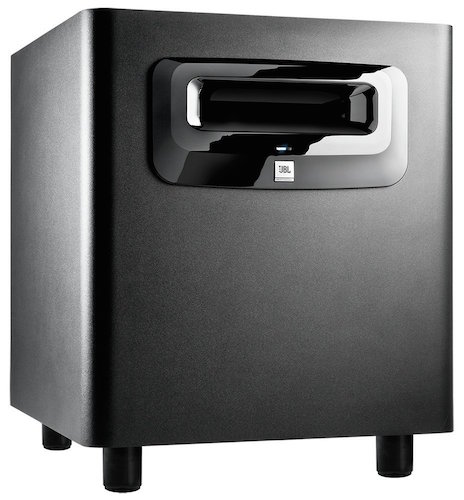
JBL LSR310S
The JBL LSR is a wonderful studio subwoofer!
It has a 10 inch speaker that provides a clear, accurate bass.
There are 2 XLR balanced outputs and 2 TRS balanced outputs. You can adjust the crossover at either 80Hz or 120Hz.
A nice feature of this sub is its selectable input-sensitivity. This lets you connect the LSR to any type of high-output equipment without worrying about overloads.
There is a nice simple volume knob on the back for leveling the sound of your sub equally to your studio monitors.
The one gripe I had with this sub is that there is no foot switch for temporarily turning off the sub. This would’ve been useful when you want to quickly reference your track without any bass.
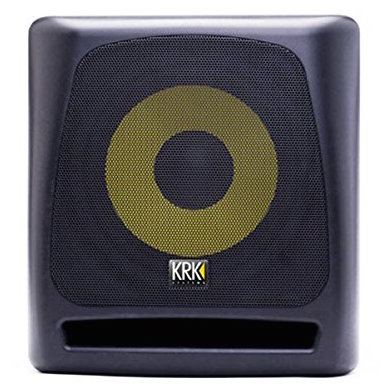
KRK K10S Powered Subwoofer
The KRK K10S is my #1 recommendation for most small studios.
I’m usually not the biggest fan of KRK, but this sub sounds VERY good and has many awesome features!
This sub does a great job at providing a very clear and flat bass response.
The speaker size is 10 inches. It has a very nice steel grill which protects the cone from getting damaged.
The frequency response starts as low as 34Hz. The lowest sound the human ear can hear is around 20Hz. This sub provides a low-enough response for any genre of music you want to produce.
I loved that KRK made this subwoofer support the bypass control! So many subs on this list forget such a simple feature. There is a nice pedal input on the back of this sub for quickly disabling the bass.
This sub might not look too huge in the pictures, but believe me, it is!
The K10S weighs 40 pounds and is rather large in person. This sub is perfect for a small to medium sized studio.

Cerwin Vega XD8s
The next sub we’ll be talking about is the Cerwin Vega XD8s.
I’ll start off by saying this is a very sleek looking sub. It is in a rectangular shape instead of your average cube sub.
The speaker size is 8 inches. There is an easy-to-access volume knob on the back for controlling volume.
There is an adjustable crossover control. It lets you select either 80Hz, 100Hz, 120Hz, or bypass mode.
You’ll find both balanced TRS and RCA inputs/outputs.
It’s worth noting that there is no foot pedal on this sub.
The size of the XD8s is very compact. It is perfect if you don’t want to stow away a huge traditionally shaped sub under your desk. This sub would be a great option if you’re producing in a tight space.
The XD8s is also nice and light. It only weighs a mere 18 pounds.
Its frequency response starts at 25Hz and provides a great low-end.
Overall, this subwoofer provides a great value for its low price. If you want to save space, and money, the Cerwin Vega XD8s might be a perfect option for your needs.
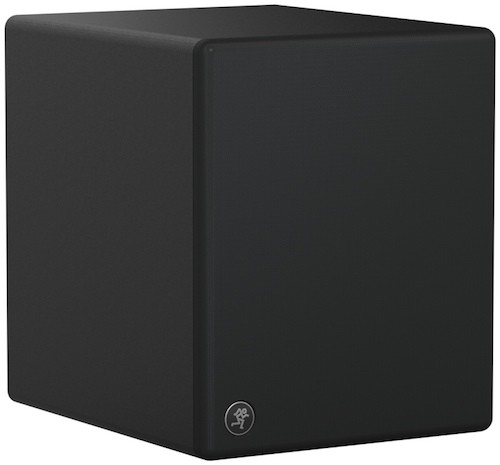
Mackie MR10Smk3
Mackie is a great pro-audio company that is best known for their high quality PA systems and their mixers.
The MR10 is a nice subwoofer that weighs just under 40 pounds. It has a nicely sized 10 inch speaker.
On the MR10, you can have control over the crossover and can select from 40Hz to 180Hz.
There are no RCA connections, but there is a balanced TRS and XLR input/output.
This sub produces a nice, flat bass response perfect for mixing. Mackie recommends this sub for their MR studio monitor series, but any studio monitor will work.
Overall, this sub is a great option.
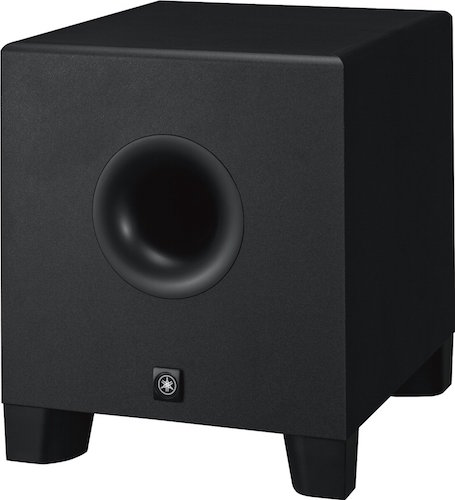
Yamaha HS8
The last studio subwoofer we’ll be talking about is the Yamaha HS8 (not to be confused with their HS8 studio monitors).
I was a big fan of Yamaha’s HS8 studio monitors. I was not surprised that their HS8 subwoofer is just as good.
The speaker size is 8 inches. It will only weigh about 30 pounds.
I liked the HS8’s simple design. The only thing I didn’t like is that there is no bypass pedal. There is, however, a nice low-cut switch on the back (there is also a high-cut).
The only inputs and outputs on this sub are XLR.
Overall, this sub is good for a small-to-medium sized studio. It provides a flat and clean sound.
Summary
So there you have it!
Those were my picks for the top 5 studio subwoofers. I hope I have truly helped you out in this article.
Don’t hesitate to ask me questions in the comment section below!
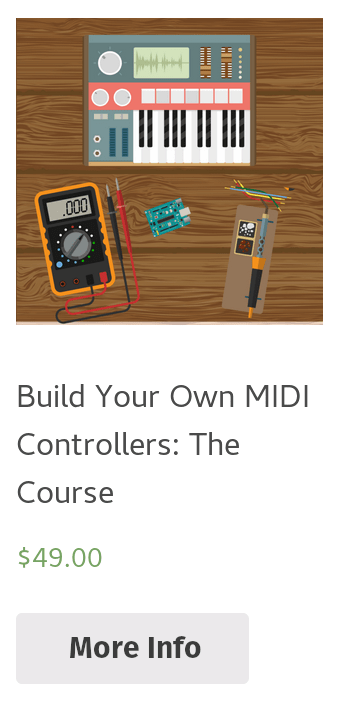
Leave a Comment
6 comments
I am a newbie and I would like to thank you for the information you answered questions I would not have asked – what monitor would you couple with the KRK sub? again thanks the information was very usefull and needed for my novice.
No problem, WorldFame! Glad I can help! I would couple the KRK sub with another KRK speaker such as the KRK RP5G3 or the RP8G3. Alternatively, you can also go for the Yamaha HS8, which is one of my favorite studio monitors of all time. Any one of those choices would be great depending on your budget.
If you’re interested, I wrote a post on my top 10 studio monitor recommendations. It was recently updated with a ton of more info and even a table-of-contents.
Thanks for reading!
-Doug
Hi, i had a question, I currently have KRK Rokit 5s as my monitor setup and am looking at a subwoofer that is NOT the KRK 10s…and I’m wondering if combining a different subwoofer like M-Audio SBX10 or Mackie MR10s with the Rokit 5 pair would be a good idea? would the sound be a little off? and would it be highly recommended to just stick with a KRK sub for KRK monitors ? Thanks in advance!!
It shouldn’t make a difference to the accuracy of your sound. :) It’s common to use a different brand sub with monitors.
Hi there, thanks a lot for the guide–it has answered questions I normally would never have asked. Anyway, I’m looking for an excellent subwoofer. There are a lot of studio subs on the market today which makes the search extremely hard, but I’m thinking I’ll probably just end up picking whatever one has the most positive reviews or something. The KRK K10S sub speakers seem to be among the best from what I’ve seen on the internet and on other best studio subs articles, but it’s my first time seeing the Cerwin Vega XD8s and I’m wondering if this is more suitable for beginners like me. What do you think?
Absolutely. The XD8 will knock your socks off. :)